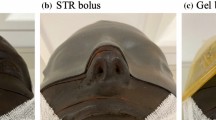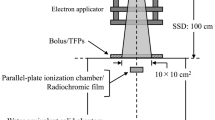Abstract
To clarify the dosimetric characteristics of a real-time variable shape rubber-containing tungsten (STR) bolus in a clinical plan and investigate the efficacy of the STR bolus in photon radiotherapy for keloids and other superficial tumors. A 5 mm gel bolus or 1 mm STR bolus was placed on a solid water phantom. Tangential irradiation was performed using a TomoTherapy Radixact-X9 and 6 MV X-ray flattening-filter-free beam, and the surface dose was measured with radiochromic film. Clinical-like plans (TomoDirect; TD and TomoHelical; TH) were applied with the same geometry and the dose distributions were measured. The increase in surface dose by the build-up effect and backscatter was 37.7% and 8.0% for the gel bolus, and 40.5% and 26.4% for the STR bolus, respectively. In the TD and TH plans, the increase in surface dose was 27.4% and 48.3% for the gel bolus, and 39.0% and 63.2% for the STR bolus. Similary, changes in the sagittal plane dose were − 3.9% and 6.1% for the gel bolus, and − 6.3% and 6.9% for the STR bolus. The STR bolus effectively increased the surface dose by the build-up effect and backscatter in photon radiotherapy for keloids and other superficial tumors.






Similar content being viewed by others
References
Martin J, Butson T, Cheung P, Yu P, Metcalfe (2000) Effects on skin dose from unwanted air gaps under bolus in photon beam radiotherapy. Radiat Meas 32(3):201–204. https://doi.org/10.1016/S1350-4487(99)00276-0
Akasaka H, Oki Y, Mizonobe K et al (2021) The air gap between bolus and skin affects dose distribution in helical and direct tomotherapy. J Radiother Pract 20(3):294–299. https://doi.org/10.1017/S1460396920000333
Sroka M, Reguła J, Lobodziec W (2010) The influence of the bolus-surface distance on the dose distribution in the build-up region. Rep Pract Oncol Radiother 15(6):161–164. https://doi.org/10.1016/j.rpor.2010.09.003
Boman E, Ojala J, Rossi M, Kapanen M (2018) Monte Carlo investigation on the effect of air gap under bolus in post-mastectomy radiotherapy. Phys Med 55:82–87. https://doi.org/10.1016/j.ejmp.2018.10.023
Carvajal CC, Ibarra CM, Arbulo DL, Russo MN, Solé CP (2016) Postoperative radiotherapy in the management of keloids. Ecancermedicalscience 10:690. https://doi.org/10.3332/ecancer.2016.690
Bischof M, Krempien R, Debus J, Treiber M (2007) Postoperative electron beam radiotherapy for keloids: objective findings and patient satisfaction in self-assessment. Int J Dermatol 46(9):971–975. https://doi.org/10.1111/j.1365-4632.2007.03326.x
Ogawa R, Miyashita T, Hyakusoku H, Akaishi S, Kuribayashi S, Tateno A (2007) Postoperative radiation protocol for keloids and hypertrophic scars: statistical analysis of 370 sites followed for over 18 months. Ann Plast Surg 59(6):688–691. https://doi.org/10.1097/SAP.0b013e3180423b32
Lin YF, Shueng PW, Roan TL et al (2020) Tomotherapy as an alternative irradiative treatment for complicated keloids. J Clin Med 9(11):3732. https://doi.org/10.3390/jcm9113732
Kal HB, Veen RE, Jürgenliemk-Schulz IM (2009) Dose-effect relationships for recurrence of keloid and pterygium after surgery and radiotherapy. Int J Radiat Oncol Biol Phys 74(1):245–251. https://doi.org/10.1016/j.ijrobp.2008.12.066
Renz P, Hasan S, Gresswell S, Hajjar RT, Trombetta M, Fontanesi J (2018) Dose effect in adjuvant radiation therapy for the treatment of resected keloids. Int J Radiat Oncol Biol Phys 102(1):149–154. https://doi.org/10.1016/j.ijrobp.2018.05.027
Huang C, Liu L, You Z, Wang B, Du Y, Ogawa R (2017) Keloid progression: a stiffness gap hypothesis. Int Wound J 14(5):764–771. https://doi.org/10.1111/iwj.12693
Kijima K, Monzen H, Matsumoto K, Tamura M, Nishimura Y (2018) The shielding ability of novel tungsten rubber against the electron beam for clinical use in radiation therapy. Anticancer Res 38(7):3919–3927. https://doi.org/10.21873/anticanres.12677
Kijima K, Krisanachinda A, Tamura M, Monzen H, Nishimura Y (2020) Reduction of occupational exposure using a novel tungsten-containing rubber shield in interventional radiology. Health Phys 118(6):609–614. https://doi.org/10.1097/HP.0000000000001177
Tamura M, Monzen H, Kubo K, Hirata M, Nishimura Y (2017) Feasibility of tungsten functional paper in electron grid therapy: a Monte Carlo study. Phys Med Biol 62(3):878–889. https://doi.org/10.1088/1361-6560/62/3/878
Takei Y, Kamomae T, Monzen H et al (2020) Feasibility of using tungsten functional paper as a thin bolus for electron beam radiotherapy. Phys Eng Sci Med 43(3):1101–1111. https://doi.org/10.1007/s13246-020-00910-2
Kamomae T, Monzen H, Kawamura M et al (2017) Dosimetric feasibility of using tungsten-based functional paper for flexible chest wall protectors in intraoperative electron radiotherapy for breast cancer. Phys Med Biol 63(1):015006. https://doi.org/10.1088/1361-6560/aa96cf
Kawai Y, Tamura M, Amano M, Kamomae T, Monzen H (2019) Dosimetric characterization of a novel surface collimator with tungsten functional paper for electron therapy. Anticancer Res 39(6):2839–2843. https://doi.org/10.21873/anticanres.13412
Monzen H, Kanno I, Fujimoto T, Hiraoka M (2017) Estimation of the shielding ability of a tungsten functional paper for diagnostic x-rays and gamma rays. J Appl Clin Med Phys 18(5):325–329. https://doi.org/10.1002/acm2.12122
Okuhata K, Tamura M, Monzen H, Nishimura Y (2021) Dosimetric characteristics of a thin bolus made of variable shape tungsten rubber for photon radiotherapy. Phys Eng Sci Med 44(4):1249–1255. https://doi.org/10.1007/s13246-021-01059-2
Monzen H, Tamura M, Kijima K et al (2019) Estimation of radiation shielding ability in electron therapy and brachytherapy with real time variable shape tungsten rubber. Phys Med 66:29–35. https://doi.org/10.1016/j.ejmp.2019.09.233
Wakabayashi K, Monzen H, Tamura M, Matsumoto K, Takei Y, Nishimura Y (2021) Dosimetric evaluation of skin collimation with tungsten rubber for electron radiotherapy: a Monte Carlo study. J Appl Clin Med Phys 22:63–70. https://doi.org/10.1002/acm2.13210
Kawai Y, Tamura M, Amano M, Kosugi T, Monzen H (2021) First clinical experience of tungsten rubber electron adaptive therapy with real-time variable-shape tungsten rubber. Anticancer Res 41(2):919–925. https://doi.org/10.21873/anticanres.14845
Al-Rahbi ZS, Cutajar DL, Metcalfe P, Rosenfeld AB (2018) Dosimetric effects of brass mesh bolus on skin dose and dose at depth for postmastectomy chest wall irradiation. Phys Med 54:84–93. https://doi.org/10.1016/j.ejmp.2018.09.009
Ashburner MJ, Tudor S (2014) The optimization of superficial planning target volumes (PTVs) with helical tomotherapy. J Appl Clin Med Phys 15(6):4560. https://doi.org/10.1120/jacmp.v15i6.4560
Choi MG, Law M, Yoon DK et al (2020) Simplified sigmoidal curve fitting for a 6 MV FFF photon beam of the Halcyon to determine the field size for beam commissioning and quality assurance. Radiat Oncol 15(1):273. https://doi.org/10.1186/s13014-020-01709-x
Richmond ND, Daniel JM, Whitbourn JR, Greenhalgh AD (2016) Dosimetric characteristics of brass mesh as bolus under megavoltage photon irradiation. Br J Radiol 89(1059):20150796. https://doi.org/10.1259/bjr.20150796
Ehler ED, Sterling DA (2020) 3D printed copper-plastic composite material for use as a radiotherapy bolus. Phys Med 76:202–206. https://doi.org/10.1016/j.ejmp.2020.07.008
Lobo D, Banerjee S, Saxena PU et al (2019) Clinical implementation of brass mesh bolus for chest wall postmastectomy radiotherapy and film dosimetry for surface dose estimates. J Cancer Res Ther 15(5):1042–1050. https://doi.org/10.4103/jcrt.JCRT_1034_17
Manger R, Paxton A, Cerviño L (2016) Dosimetric assessment of brass mesh bolus for postmastectomy photon radiotherapy. J Appl Clin Med Phys 17(6):86–96. https://doi.org/10.1120/jacmp.v17i6.6221
Acknowledgements
The authors thank Ashleigh Cooper, PhD, from Edanz Group (https://en-author-services.edanzgroup.com/ac) for editing a draft of this manuscript.
Funding
This work was supported partly by Japan Society for the Promotion of Science (JSPS) KAKENHI (Grant No. 19K08211).
Author information
Authors and Affiliations
Contributions
HM and YS designed the conceptual ideas. YS and KN performed the experiments and analyzed the data. The first draft of the manuscript was written by YS and all authors commented on previous versions of the manuscript. All authors read and approved the final manuscript.
Corresponding author
Ethics declarations
Conflict of interest
Hajime Monzen received a research donation from Hayakawa Rubber Co., Ltd.
Informed consent
This article does not involve patient data.
Research involving human and/or animal participants
This article does not contain any studies with human participants or animals performed by any of the authors.
Additional information
Publisher’s Note
Springer Nature remains neutral with regard to jurisdictional claims in published maps and institutional affiliations.
Rights and permissions
Springer Nature or its licensor (e.g. a society or other partner) holds exclusive rights to this article under a publishing agreement with the author(s) or other rightsholder(s); author self-archiving of the accepted manuscript version of this article is solely governed by the terms of such publishing agreement and applicable law.
About this article
Cite this article
Sakai, Y., Monzen, H., Tamura, M. et al. Double enhancement effect of a surface dose with tungsten rubber bolus in photon radiotherapy for keloids and superficial tumors. Phys Eng Sci Med 46, 179–184 (2023). https://doi.org/10.1007/s13246-022-01208-1
Received:
Accepted:
Published:
Issue Date:
DOI: https://doi.org/10.1007/s13246-022-01208-1




